Numerical Studies on the Design of Self-Resetting Active Bistable Cross-Shaped Structure for Morphing Applications †
Abstract
:1. Introduction
2. Numerical Analysis
2.1. Initial
2.2. Cool Down
2.3. MFC Activation
2.4. Snap-Through and Snap-Back
3. Problem Definition
4. Results and Discussion
4.1. Cool Down Shapes
4.2. Selection of MFCs
4.3. MFC Bonded Bistable Shapes
4.4. Snap-Through Voltages
5. Conclusions
Funding
Acknowledgments
Conflicts of Interest
Abbreviations
| MFC | Macro Fibre Composites |
| FE | Finite Elements |
References
- Emam, S.A.; Inman, D.J. A review on bistable composite laminates for morphing and energy harvesting. Appl. Mech. Rev. 2015, 67, 060803. [Google Scholar] [CrossRef]
- Hyer, M.W. Calculation of the room-temperature shapes of unsymmetric laminates. J. Compos. Mater. 1981, 15, 296–310. [Google Scholar] [CrossRef]
- Dai, F.H.; Zhang, B.M.; He, X.D.; Du, S.Y. Numerical and experimentalstudies on cured shape of thin unsymmetric Carbon/Epoxy compositelaminates. Key Eng. Mater. 2007, 334–335, 137–140. [Google Scholar] [CrossRef]
- Kebadze, E.; Guest, S.D.; Pellegrino, S. Bistable prestressed shell structures. Int. J. Solids Struct. 2004, 41, 2801–2820. [Google Scholar] [CrossRef]
- Daynes, S.; Potter, K.D.; Weaver, P.M. Bistable prestressed buckled laminates. Compos. Sci. Technol. 2009, 68, 3431–3437. [Google Scholar] [CrossRef]
- Yokozeki, T.; Takeda, S.I.; Ogasawara, T.; Ishikawa, T. Mechanicalproperties of corrugated composites for candidate materials of flexible wingstructures. Compos. Part A 2006, 37, 1578–1586. [Google Scholar] [CrossRef]
- Cho, M.; Kim, M.H.; Choi, H.S.; Chung, C.H.; Ahn, K.J.; Eom, Y.S. A study on the room-temperature curvature shapes of unsymmetric laminates including slippageeffects. J. Compos. Mater. 1998, 32, 460–482. [Google Scholar] [CrossRef]
- Pirrera, A.; Avitabile, D.; Weaver, P.M. Bistable plates for morphing structures: Arefined analytical approach with high-order polynomials. Int. J. Solids Struct. 2010, 47, 3412–3425. [Google Scholar] [CrossRef]
- Haldar, A.; Reinoso, J.; Jansen, E.; Rolfes, R. Thermally induced multistable configurations of variable stiffness composite plates: Semi- analytical and finite element investigation. Compos. Struct. 2018, 183, 161–175. [Google Scholar] [CrossRef]
- Haldar, A.; Groh RM, J.; Jansen, E.; Weaver, P.M. An efficient semi-analytical framework to tailor snap-through loads in bistable variable stiffness laminates. Int. J. Solids Struct. 2020, 195, 91–107. [Google Scholar] [CrossRef]
- Schlecht, M.; Schulte, K.; Hyer, H.W. Advanced calculation of the room-temperature shapes of thin unsymmetric composite laminates. Compos. Struct. 1995, 33, 627–633. [Google Scholar] [CrossRef]
- Schlecht, M.; Schulte, K. Advanced calculation of the room-temperature shapes of unsymmetric laminates. J. Compos. Mater. 1999, 33, 1472–1490. [Google Scholar] [CrossRef]
- Anilkumar, P.M.; Haldar, A.; Jansen, E.; Rao, B.N.; Rolfes, R. Effect of actuation procedure in MFC actuators for morphing of bistable laminates. In Proceedings of the 11th Structural Engineering Convention, Jadavpur University, Kolkata, India, 19–21 December 2018; pp. 37–42. [Google Scholar]
- Attada, P.K.; Parapparambil Muraleedharan Nair, A.; Bhairavavajjula, N.R. Study on the actuation force of triangular bistable composite laminates. Mater. Des. Process. Commun. 2020, e168. [Google Scholar] [CrossRef]
- Haldar, A.; Reinoso, J.; Jansen, E.; Rolfes, R. Snap-Through of Bistable Configurations Generated from Variable Stiffness Composites. In Multiscale Modeling of Heterogeneous Structures. Lecture Notes in Applied and Computational Mechanics; Sorić, J., Wriggers, P., Allix, O., Eds.; Springer: Berlin/Helderburg, Germany, 2018; p. 86. [Google Scholar]
- Diaconu, C.G.; Weaver, P.M.; Mattioni, F. Concepts for morphing airfoil sections using bistable laminated composite structures. Thin-Walled Struct. 2008, 46, 689. [Google Scholar] [CrossRef]
- Mattioni, F.; Weaver, P.M.; Potter, K.D.; Friswell, M.I. The application of thermally induced multistable composites to morphing aircraft structures. In Proceedings of the 15th International Symposium on: Smart Structures and Materials and Nondestructive Evaluation and Health Monitoring, San Diego, CA, USA, 9–13 March 2008; p. 693012. [Google Scholar]
- Daynes, S.; Weaver, P.; Potter, K. Aeroelastic study of multistable composite airfoils. J. Aircr. 2009, 46, 2169. [Google Scholar] [CrossRef]
- Daynes, S.; Nall, S.; Weaver, P.; Potter, K.; Margaris, P.; Mellor, P. On a Bistable Flap for an Airfoil. In Proceedings of the 50th AIAA/ASME/ASCE/AHS/ASC Structures, Structural Dynamics, and Materials Conference, Palm Springs, CA, USA, 4–7 May 2009. [Google Scholar]
- Arrieta, A.F.; Kuder, I.K.; Waeber, T.; Ermanni, P. Variable stiffness characteristics of embeddable multi-stable composites. Compos. Sci. Technol. 2014, 97, 12. [Google Scholar] [CrossRef]
- Kuder, I.K.; Arrieta, A.F.; Rist, M.; Ermanni, P. Aeroelastic response of a selectively compliant morphing aerofoil featuring integrated variable stiffness bistable laminates. J. Intell. Mater. Syst. Struct. 2016, 27, 1949. [Google Scholar] [CrossRef]
- Zhang, Z.; Wu, H.L.; Wu, H.P.; He, X.Q.; Bao, Y.M.; Chai, G.Z. Bistable characteristics of irregular anti-symmetric lay-up composite cylindrical shells. Int. J. Struct. Stab. Dyn. 2013, 13, 1350029. [Google Scholar] [CrossRef]
- Zhang, Z.; Li, Y.; Wu, H.L.; Chen, D.D.; Yang, J.; Wu, H.P.; Jiang, S.F.; Chai, G.Z. Viscoelastic bistable behaviour of antisymmetric laminated composite shells with time-temperature dependent properties. Thin Wall. Struct. 2018, 122, 403–415. [Google Scholar] [CrossRef]
- Zhang, Z.; Li, Y.; Wu, H.L.; Zhang, H.Q.; Wu, H.P.; Jiang, S.F.; Chai, G.Z. Mechanical analysis of functionally graded graphene oxide-reinforced composite beams based on the first-order shear deformation theory. Mech. Adv. Mater. Struc. 2020, 27, 3–11. [Google Scholar] [CrossRef]
- Zhang, Z.; Ma, W.L.; Wu, H.L.; Wu, H.P.; Jiang, S.F.; Chai, G.Z. A rigid thick Miura-Ori structure driven by bistable carbon fibre-reinforced polymer cylindrical shell. Compos. Sci. Technol. 2018, 167, 411–420. [Google Scholar] [CrossRef]
- Ma, W.L.; Zhang, Z.; Zhang, H.; Li, Y.; Wu, H.P.; Jiang, S.F.; Chai, G. An origami-inspired cube pipe structure with bistable anti-symmetric CFRP shells driven by magnetic field. Smart Mater. Struct. 2019, 28, 025028. [Google Scholar] [CrossRef]
- Hu, J.Q.; Lin, S.; Da, F.H. Pattern Reconfigurable Antenna Based on Morphing Bistable Composite Laminates. IEEE Trans. Antennas Propag. 2017, 65, 2196–2207. [Google Scholar] [CrossRef]
- Zhang, Z.; Pei, K.; Sun, M.; Wu, H.; Yu, X.; Wu, H.; Zhang, F. A Novel Solar Tracking Model Integrated with Bistable Composite Structures and Bimetallic Strips. Compos. Struct. 2020, 248, 112506. [Google Scholar] [CrossRef]
- Kim, H.A.; Betts, D.; Salo, A.I.; Bowen, C.R. Shape memory alloy actuatiofor asymmetric bistable composites. In Proceedings of the 17th Annual International Conference on Composites/Nano Engineering; University of Bath, Bath, UK; 2009. [Google Scholar]
- Gandhi, Y.; Pirondi, A.; Collini, L. Analysis of bistable composite laminate with embedded sma actuators. Procedia Struct. Integr. 2018, 12, 429–437. [Google Scholar] [CrossRef]
- Haldar, A.; Jansen, E.; Hofmeister, B.; Bruns, M.; Rolfes, R. Analysis of Novel Morphing Trailing Edge Flap Actuated by Multistable Laminates. AIAA J. 2020, 1–10. [Google Scholar] [CrossRef]
- Dano, M.L. SMA-Induced Deformations in General Unsymmetric Laminates. Ph.D. Dissertation, School of Aerospace Engineering, Georgia Institute of Technology, Atlanta, GA, USA, 1997. [Google Scholar]
- Schultz, M.R.; Hyer, M.W.; Williams, R.B.; Wilkie, W.K.; Inman, D.J. Snap-through of unsymmetric laminates using piezocomposite actuators. Compos. Sci. Technol. 2006, 66, 2442–2448. [Google Scholar] [CrossRef]
- Tawfik, S.A.; Dancila, D.S.; Armanios, E. Unsymmetric compositelaminates morphing via piezoelectric actuators. Compos. Part A 2011, 42, 748–756. [Google Scholar] [CrossRef]
- Schultz, M.R.; Wilkie, W.K.; Bryant, R.G. Investigation of self-resetting active multistable laminates. J. Aircr. 2007, 44, 1069–1076. [Google Scholar] [CrossRef]
- Anilkumar, P.M.; Haldar, A.; Jansen, E.; Rao, B.N.; Rolfes, R. Design optimization of multistable variable-stiness laminates. Mech. Adv. Mater. Struct. 2019, 26, 48–55. [Google Scholar] [CrossRef]
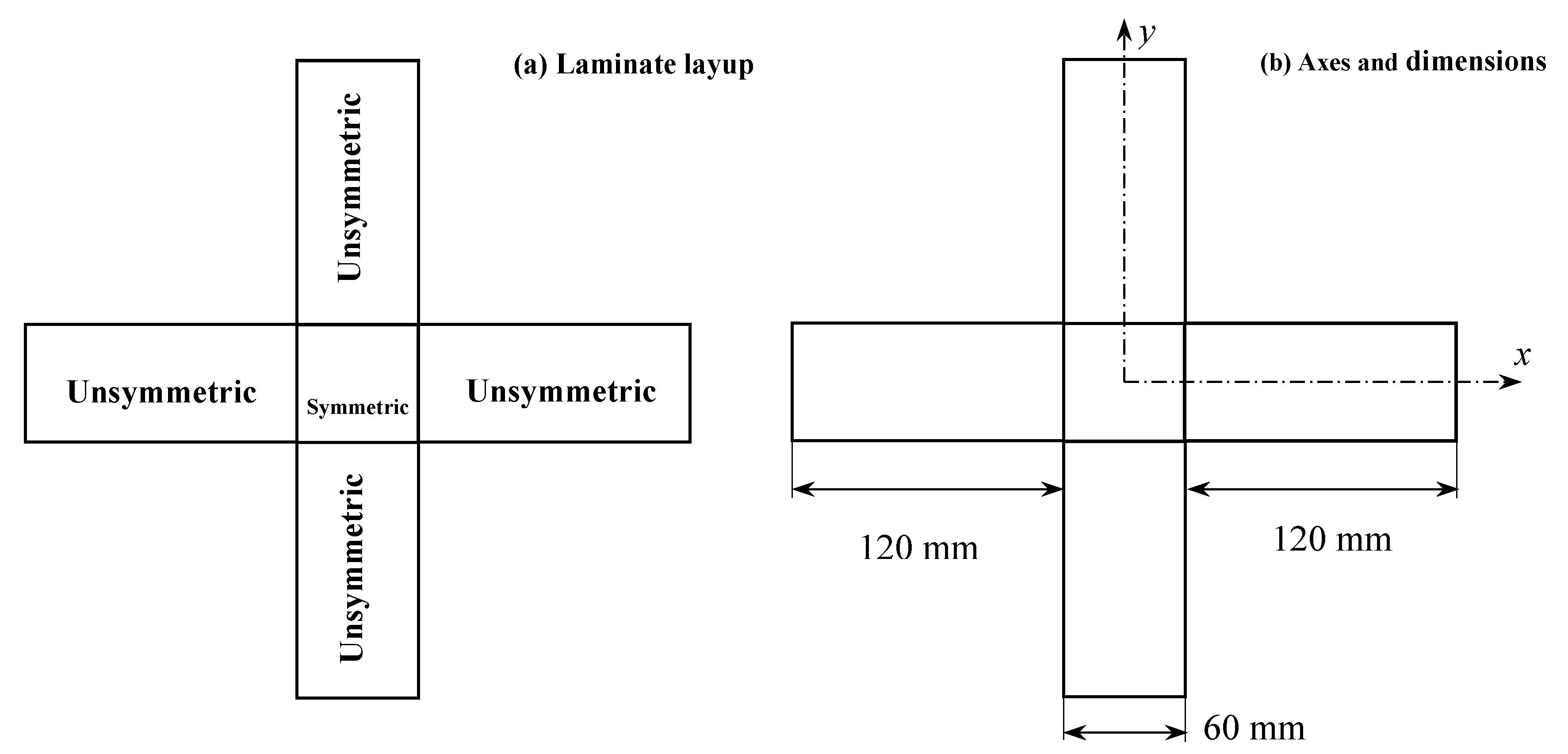

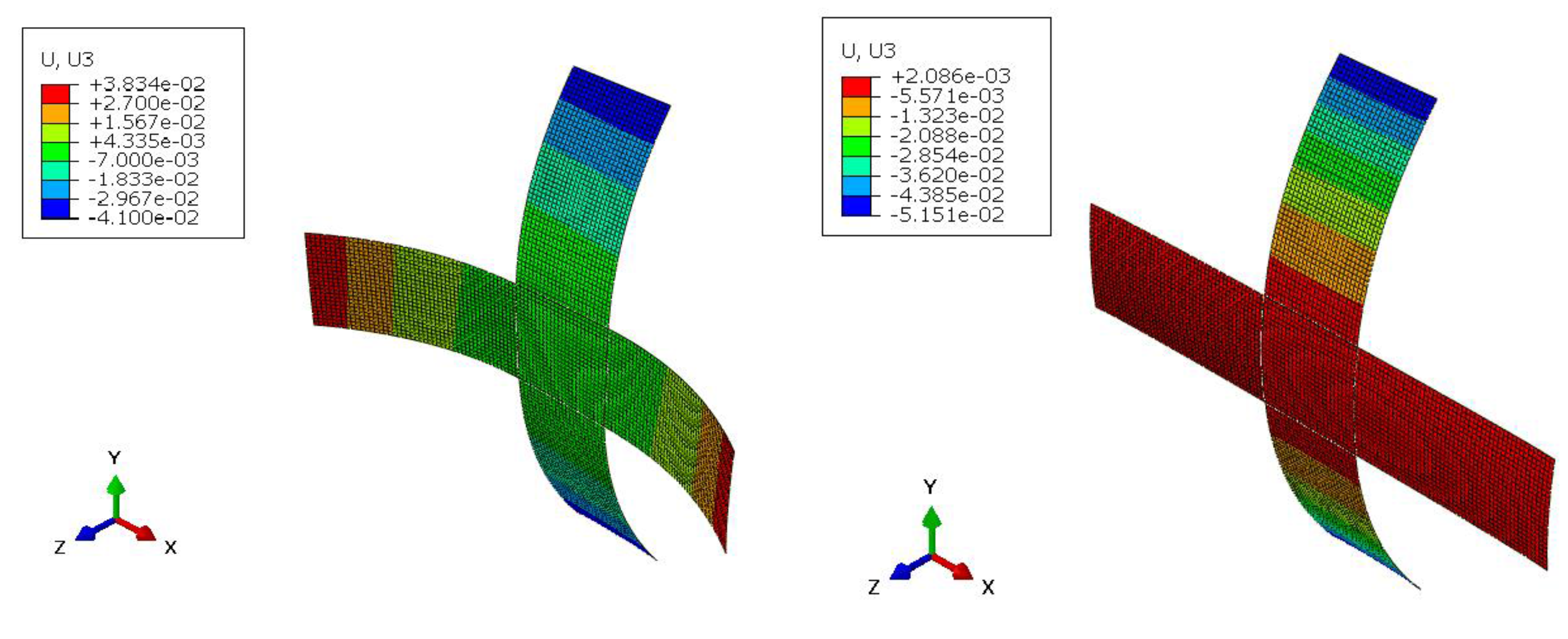
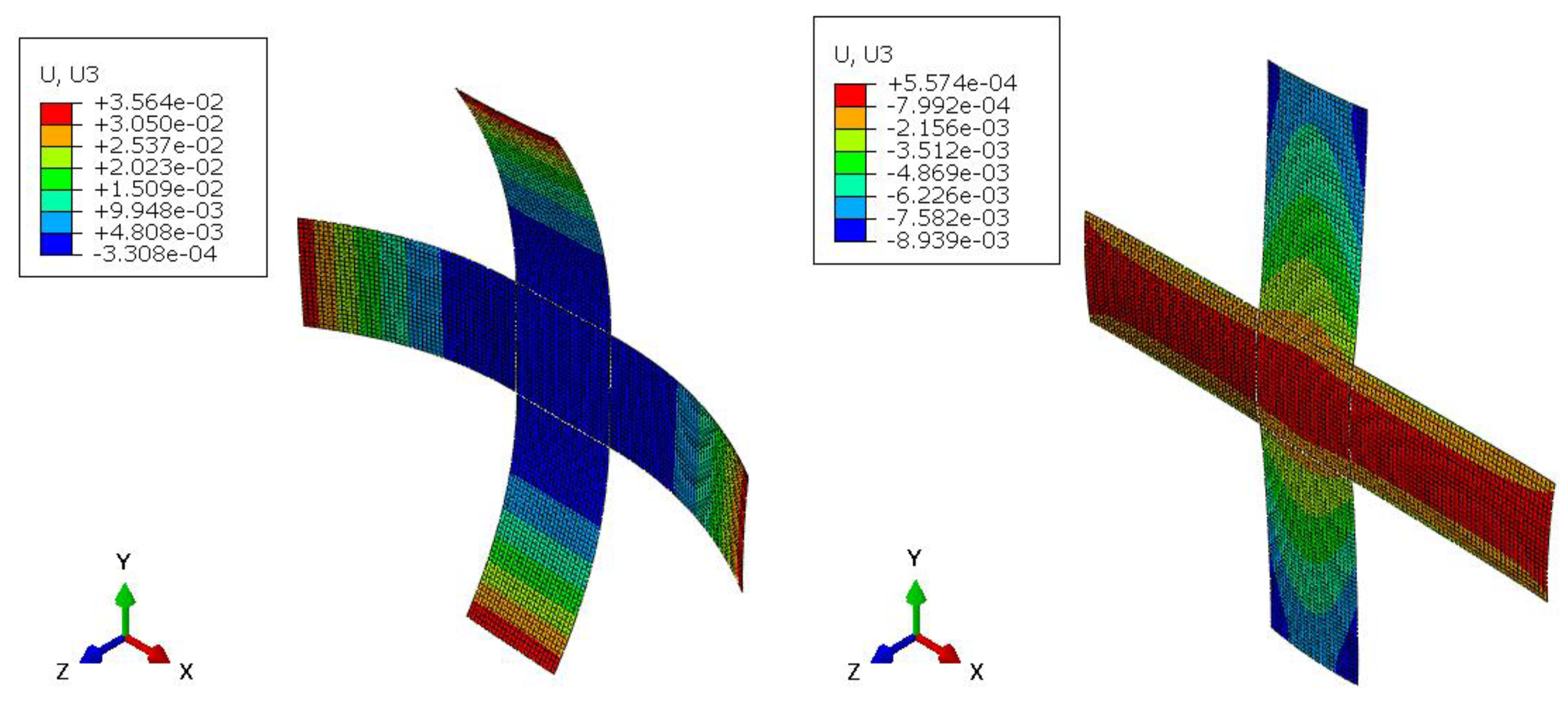
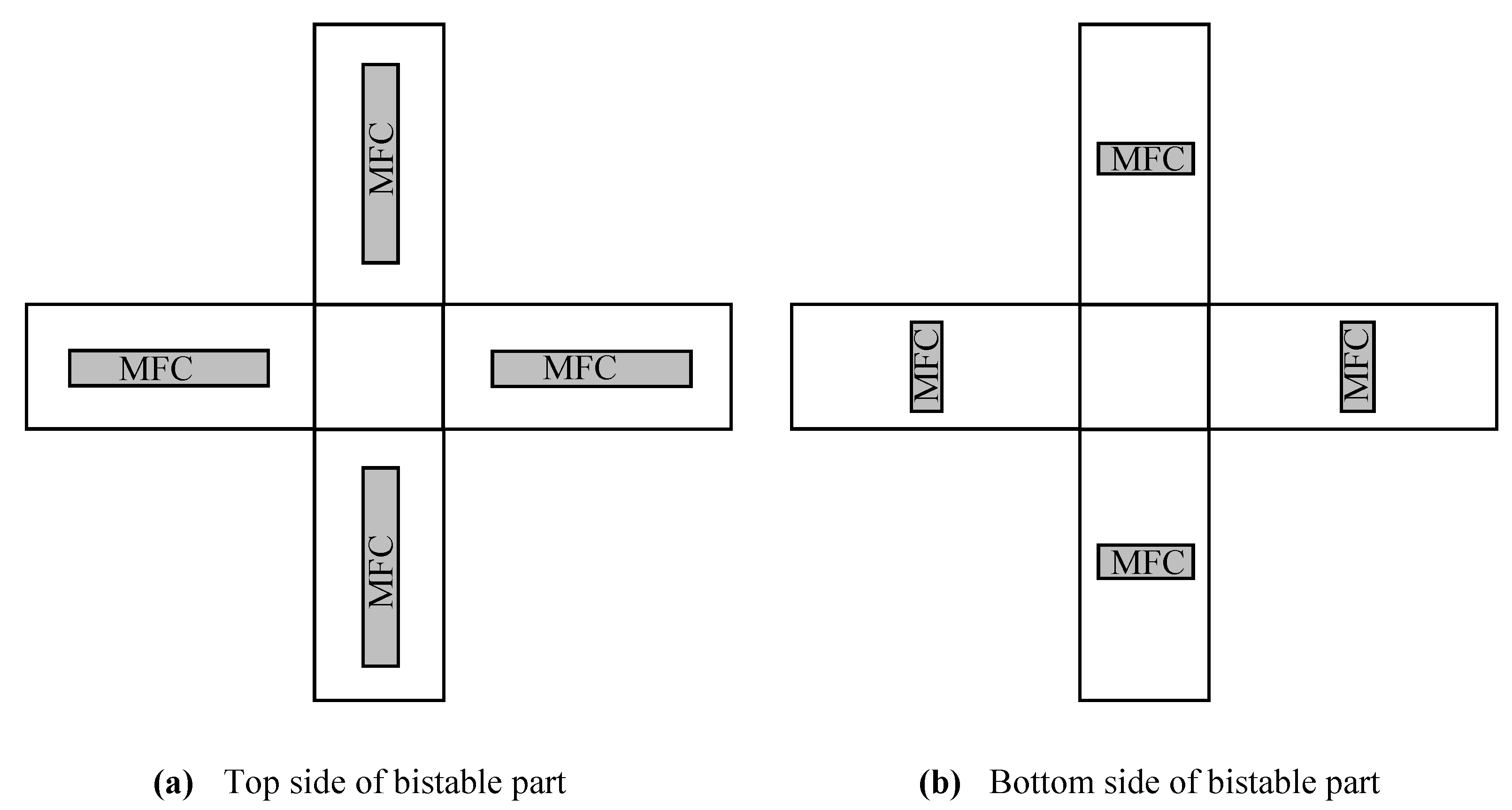

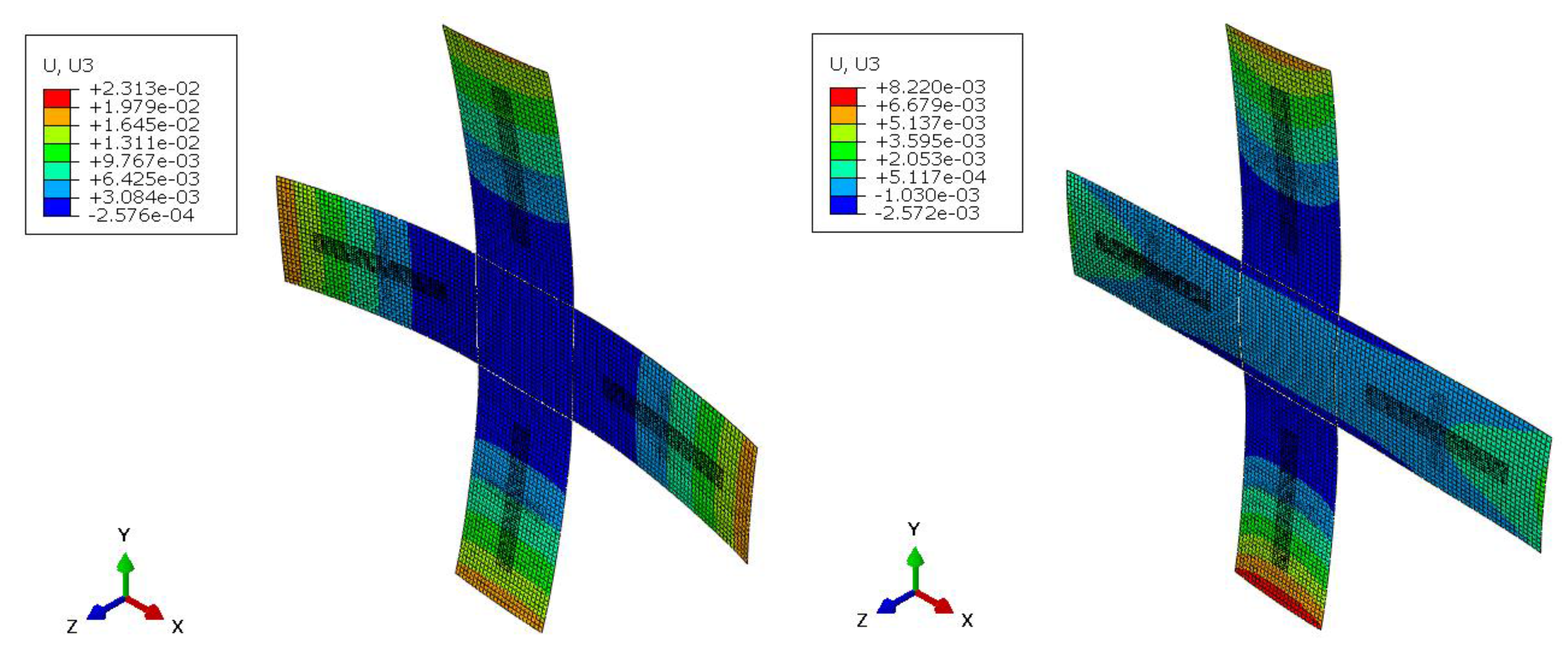
| E1 | E2 | ν12 | G12 | α11 | α22 | t |
|---|---|---|---|---|---|---|
| 140 GPa | 13 GPa | 0.3 | 6.6 GPa | −0.8 × 10−6/°C | 29 × 10−6/°C | 0.149 mm |
| Geometry Chosed | Location Chosed (mm,mm) | Out-of-Plane Displacement (mm) | |
|---|---|---|---|
| Stable Shape 1 | Stable Shape 2 | ||
| Geometry-1 | (x,y) = (150,0) | 37.80 | 2.08 |
| (x,y) = (0,−150) | −40.50 | −51.43 | |
| (x,y) = (−150,0) | 37.80 | 2.08 | |
| (x,y) = (0,150) | −40.50 | −51.43 | |
| Geometry-2 | (x,y) = (150,0) | 34.88 | 0.746 |
| (x,y) = (0,−150) | 35.64 | −4.88 | |
| (x,y) = (−150,0) | 34.88 | 0.746 | |
| (x,y) = (0,150) | 35.64 | −4.88 | |
| Geometry Chosen | Location Chosen (mm,mm) | Out-of-Plane Displacement (mm) | |
|---|---|---|---|
| Stable Shape 1 | Stable Shape 2 | ||
| Geometry-2 | (x,y) = (150,0) | 22.71 | 2.43 |
| (x,y) = (0,−150) | 23.26 | 8.22 | |
| (x,y) = (−150,0) | 22.71 | 2.43 | |
| (x,y) = (0,150) | 23.26 | 8.22 | |
| Snap Action | Voltage (V) | |
|---|---|---|
| Snap-through | Top MFC | 3196 |
| Bottom MFC | −799 | |
| Snap-back | Top MFC | 3640 |
| Bottom MFC | −910 | |
Publisher’s Note: MDPI stays neutral with regard to jurisdictional claims in published maps and institutional affiliations. |
© 2020 by the authors. Licensee MDPI, Basel, Switzerland. This article is an open access article distributed under the terms and conditions of the Creative Commons Attribution (CC BY) license (https://creativecommons.org/licenses/by/4.0/).
Share and Cite
Anilkumar, P.M.; Haldar, A.; Scheffler, S.; Rao, B.N.; Rolfes, R. Numerical Studies on the Design of Self-Resetting Active Bistable Cross-Shaped Structure for Morphing Applications. Proceedings 2020, 64, 16. https://doi.org/10.3390/IeCAT2020-08482
Anilkumar PM, Haldar A, Scheffler S, Rao BN, Rolfes R. Numerical Studies on the Design of Self-Resetting Active Bistable Cross-Shaped Structure for Morphing Applications. Proceedings. 2020; 64(1):16. https://doi.org/10.3390/IeCAT2020-08482
Chicago/Turabian StyleAnilkumar, P. M., A. Haldar, S. Scheffler, B. N. Rao, and R. Rolfes. 2020. "Numerical Studies on the Design of Self-Resetting Active Bistable Cross-Shaped Structure for Morphing Applications" Proceedings 64, no. 1: 16. https://doi.org/10.3390/IeCAT2020-08482
APA StyleAnilkumar, P. M., Haldar, A., Scheffler, S., Rao, B. N., & Rolfes, R. (2020). Numerical Studies on the Design of Self-Resetting Active Bistable Cross-Shaped Structure for Morphing Applications. Proceedings, 64(1), 16. https://doi.org/10.3390/IeCAT2020-08482




